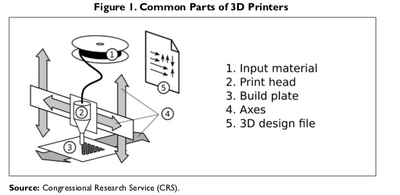Definition
A 3-D printer (also called a solid-object printer)
| “ | "prints" sophisticated three-dimensional objects based on instructions from a computer.[1] | ” |
How a 3-D printer works
In general, 3D printers have five common parts: input material, print head, build plate, axes, and 3D design file (see Figure 1).
- Input material — 3D-printed parts begin as input material. This material can be in the form of solid filament, pellets, liquid, or powder.
- Print head — The input material is deposited at the tip of the print head. This process can occur through a variety of methods, including pushing filament or pellets through a metal extruder, using a laser to melt powder, or using a light to solidify liquid.
- Build plate — The build plate is the base (flat surface) upon which the part is constructed. At the beginning of the 3D printing process, the print head is nearly touching the build plate. As more layers are added to the part, the distance between the print head and the build plate increases.
- Axes — The axes move the print head relative to the build plate. This enables the 3D printer to create a particular pattern for each new layer of material. The final part is made up of the patterns in each layer, stacked on top of each other.
- 3D design file — The 3D printing process is governed by a digital 3D design file. This file provides instructions to the 3D printer that describe how to move the axes, which in turn move the position of the print head relative to the build plate. The file controls exactly what patterns are produced in each layer; this determines which kind of part is produced by the 3D printer.
References
- ↑ Riel Miller, Wolfgang Michalski & Barrie Stevens, "The Future of Money", in The Future of Money, at 21.
